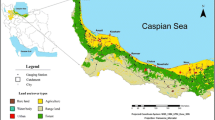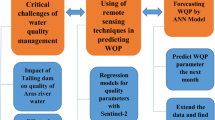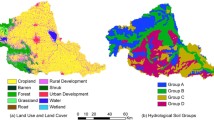Abstract
This paper investigates the use of an artificial neural network (ANN) model to predict dissolved organic carbon (DOC) in a river network and evaluates the impacts of watershed characteristics on stream DOC. Samples and relevant environmental variables were obtained from field sampling at 28 hydrological response units (HRUs) and a MODIS/SRTM DEM satellite image. HRUs can provide reliable spatial interpolation for filling data gaps and incorporate potential spatial correlation among observations in each ANN neuron. The process and results of neural network modeling were assessed by deterministic and statistical methods and spatial regression kriging. The spatial prediction results show that ANN, using improved back propagation algorithms of 7-15-1 architecture, was the optimal network, by which predictions maintained most of the original spatial variation and eliminated smoothing effects of RK. The sum of the relative contributions of four sensitive variables, including soil organic carbon density, geographic longitude, surface runoff and Chl a in river water, was >75 %. A minor prediction error of ~6 % was found in HRUs of open shrublands, but HRUs of urban and croplands had an error of 24–30 %. This pattern exemplifies anthropogenic impacts in urban areas on stream DOC and agricultural activities in croplands. The usefulness of ANN modeling-based GIS in this study is demonstrated by depiction of spatial variation of stream DOC and indicates the benefits of understanding sensitive factors for watershed impact assessments.









Similar content being viewed by others
References
Aitkenhead MJ, Aitkenhead-Peterson JA, McDowell WH, Smart RP, Cresser MS (2007) Modelling DOC export from watersheds in Scotland using neural networks. Comput Geosci 33:423–436
Amiri BJ, Nakane K (2009) Modeling the linkage between river water quality and landscape metrics in the Chugoku district of Japan. Water Resour Manag 23(5):931–956
Berner RA (1992) Weathering, plants and the long term carbon cycle. Geochemica et Cosmochimica Acta 56:3225–3231
Chow AT, Tanji KK, Gao S (2003) Production of dissolved organic carbon (DOC) and trihalomethane precursor (THM) from peat soils. Water Res 37:4475–4485
Clair T, Ehrman JM (1998) Using neural networks to assess the influence of changing seasonal climates in modifying discharge dissolved organic carbon, and nitrogen export in eastern Canadian rivers. Water Resour Res 34(3):447–455
Cooper DM, Jenkins A, Skeffington R, Gannon B (2000) Catchment-scale simulation of stream water chemistry by spatial mixing: theory and application. J Hydrol 233:121–137
Dimirovski GM, Jing YW (2002) Kolmogorov networks and process characteristic input-output modes decomposition. First Int IEEE Symp Intell Syst 1:59–66
Fang JY, Liu GH, Xu SL (1996) Carbon reservoir of terrestrial ecosystem in China. In: Gengchen Wang, Yupu Wen (eds) Monitoring and relevant process of greenhouse gas concentration and emission. China Environment Sciences Publishing House, Beijing, pp 109–128 (In Chinese)
Futter MN, Wit HAD (2008) Testing seasonal and long-term controls of stream water DOC using empirical and process-based models. Sci Total Environ 4(5):3175–3207
Futter MN, Butterfield D, Cosby BJ, Dillon PJ, Wade AJ, Whitehead PG (2007) Modeling the mechanisms that control in-stream dissolved organic carbon dynamics in upland and forested catchments. Water Resour Res 43(2):1–16
Galy A, France-Lanord C (1999) Weathering processes in the Ganges-Brahmaputra basin and the river alkalinity budget. Chem Geol 159:31–60
Gao QZ, Tao Z (2010) Chemical weathering and chemical runoffs in the seashore granite hills in South China. Sci China Earth Sci 8(53):1195–1204
Gao QZ, Shen C, Sun Y, Wei X (2001) A preliminary study on the organic carbon weathering fluxes in Beijiang River drainage. Environ Sci 22:12–18 (in Chinese)
Garson GD (1998) Neural networks, an introductory guide for social scientists. Sage Publications, California
Goovaerts P, AvRuskin G, Meliker J, Slotnick M, Jacquez G, Nriagu J (2005) Geostatistical modeling of the spatial variability of arsenic in groundwater of southeast Michigan. Water Resour Res 41(7):W07013
Grunwald S, Reddy KR, Newman S, DeBusk WF (2004) Spatial variability, distribution and uncertainty assessment of soil phosphorus in a south Florida wetland. Environmetrics 15(8):811–825
Hagan MT, Demuth HB, De Jesus O (2002) An introduction to the use of neural networks in control systems. Int J Robust Nonlinear Control 12(11):959–985
He BY, Dai MH, Zhai WD, Wang LF, Wang KJ, Chen JH, Lin JR, Han AQ (2010) Distribution, degradation and dynamics of dissolved organic carbon and its major compound classes in the Pearl River estuary, China. Mar Chem 119:52–64
Ho KC, Chow YL, Yau JT (2003) Chemical and microbiological qualities of The East River (Dongjiang) water, with particular reference to drinking water supply in Hong Kong. Chemosphere Environ Pub Health Manag 52(9):1441–1450
Hongve D, Riise G, Kristiansen JF (2004) Increased color and organic acid concentrations in Norwegian forest lakes and drinking water: a result of increased precipitation. Aquat Sci 66:231–238
Hu JF, Peng PA, Jia GD, Mai BX, Zhang G (2006) Distribution and sources of organic carbon, nitrogen and their isotopes in sediments of the subtropical Pearl River estuary and adjacent shelf, Southern China. Mar Chem 98:274–285
Huang XP, Huang LM, Yue WZ (2003) The characteristic of nutrients and eutrophication in the Pearl River estuary, South China. Mar Pollut Bull 47:30–36
Joshi A, Ramakrishman N, Houtis EN, Rice JR (1997) On neurobiological, neuro-fuzzy, machine learning, and statistical pattern recognition techniques. IEEE Trans Neural Netw 8:18–31
Lennon JT (2004) Experimental evidence that terrestrial carbon subsidies increase CO2 flux from lake ecosystems. Oecologia 138:584–591
Li Z, Sun B, Lin XX (2001) Density of soil organic carbon and the factors controlling its turnover in East China. Scientia Geographica Sinica 21(4):301–307
Lischeid G (2001) Investigating short-term dynamics and long-term trends of SO4 in the runoff of a forested catchment using artificial neural networks. J Hydrol 243:31–42
Maria H, Martin F, Michael S, Markus H (2006) An application of artificial neural networks to carbon, nitrogen and phosphorus concentrations in three boreal streams and impacts of climate change. Ecol Model 195:51–60
Mitchell TM (1999) Machine learning and data mining. Commun ACM 42(11):30–36
Money E, Carter GP, Serre ML (2009) Using river distances in the space/time estimation of dissolved oxygen along two impaired river networks in New Jersey. Water Res 43:1948–1958
Nash JE, Sutcliffe JV (1970) River flow forecasting through conceptual models, part I—a discussion of principles. J Hydrol 10:282–290
Nielsen RH (1987) Kolmogorovns’mapping neural network existing theorem. In: Proceeding of the international conference on neural networks, III, IEEE Press, New York, pp 11–13
OGSS (Office of Guangdong Soil Survey) (1996) Guangdong Soil, vol 1. Science Press, Beijing, pp 129–164 (in Chinese)
Olea R (1996) Compensating for estimation smoothing in Kriging. Math Geol 28(4):4072–4171
Peterson EE, Merton AA, Theobald DM, Urquhart NS (2006) Patterns of spatial autocorrelation in stream water chemistry. Environ Monit Assess 121:615–638
Rothwell JJ, Dise NB, Taylor KG, Allott THE, Allott THE, Davies H, Neal C (2010) Predicting river water quality across North West England using catchment characteristics. J Hydrol 395(3–4):153–162
Su ZY, Xiong YM, Zhu JY, Ye YC, Ye M (2006) Soil organic carbon content and distribution in a small landscape of Dongguan, South China. Pedosphere 16(1):10–17
Wang XC, Che RF, Gardner GB (2004) Sources and transport of dissolved and particulate organic carbon in the Mississippi River estuary and adjacent coastal waters of the northern Gulf of Mexico. Mar Chem 89:241–256
Wei XG (2003) Study on river carbon flux and erosion of Zhujiang (Pearl River) drainage basin. Dissertation, Guangzhou Institute of Geochemistry, Chinese Academy of Science (in Chinese)
Wu HB, Guo ZT, Peng CH (2003) Land use induced changes of organic carbon storage in soils of China. Glob Change Biol 9:305–315
Wu Y, Zhang J, Liu SM, Zhang ZF, Yao QZ, Hong GH, Cooper L (2007) Sources and distribution of carbon within the Yangtze River system. Estuar Coast Shelf Sci 71:13–25
Yang XY, Wei J (2010) GIS-based spatial regression and prediction of water quality in river networks, a case study in Iowa. J Environ Manag 91:1943–1951
Zeng J, Guo HF, Hu YM (2007) Artificial neural network model for identifying taxi gross emitter from remote sensing data of vehicle emission. J Environ Sci 194(4):427–431
Zhang SR, Liu XX, Higgitt DL, Chen CTA, Sun HG, Han JT (2007) Water chemistry of the Zhujiang (Pearl River): natural processes and anthropogenic influences. J Geophys Res 112:1–17
Acknowledgments
This work was supported by the Universities Disciplinary and Special Construction Funds from the Guangdong Province Foundation (C10092), National Natural Science Foundation of China (No. 41101152, No. 40901090), and the Scientific Research Foundation for Returned Overseas Chinese Scholars, State Education Ministry. The authors thank the Hydrology Bureau of Huizhou for assistance with river DOC sampling.
Author information
Authors and Affiliations
Corresponding author
Rights and permissions
About this article
Cite this article
Fu, Y., Zhao, Y., Zhang, Y. et al. GIS and ANN-based spatial prediction of DOC in river networks: a case study in Dongjiang, Southern China. Environ Earth Sci 68, 1495–1505 (2013). https://doi.org/10.1007/s12665-012-2177-y
Received:
Accepted:
Published:
Issue Date:
DOI: https://doi.org/10.1007/s12665-012-2177-y




